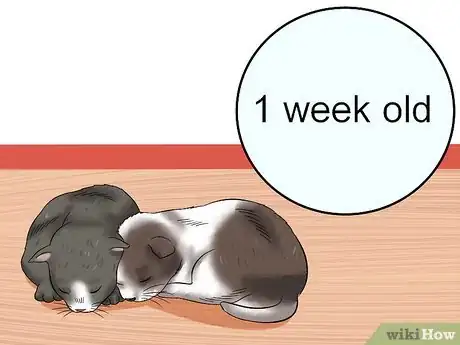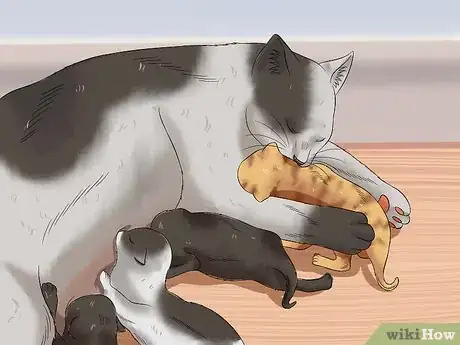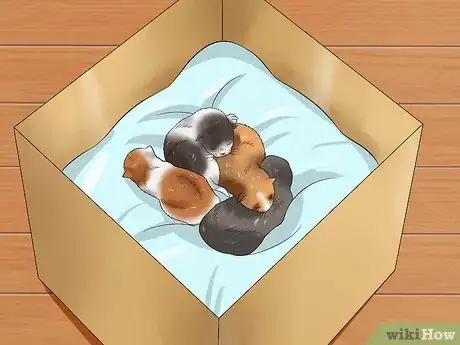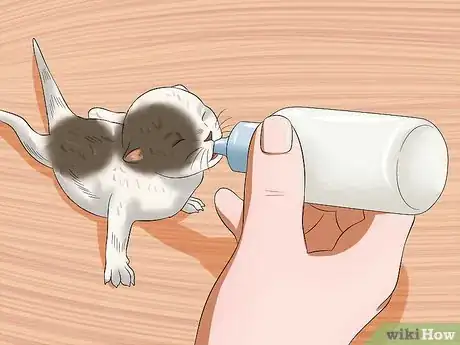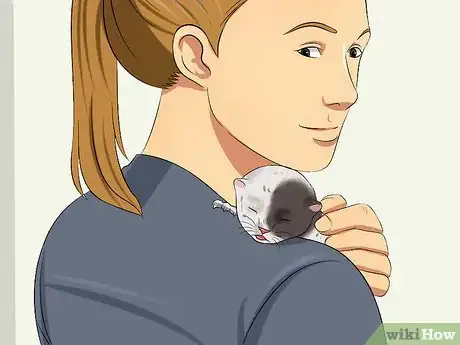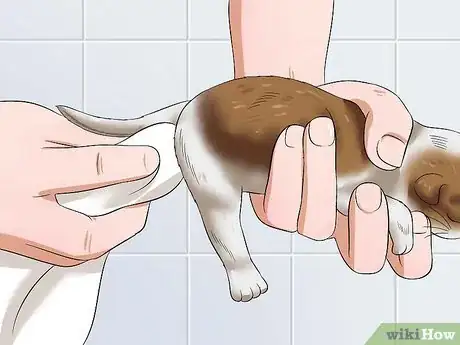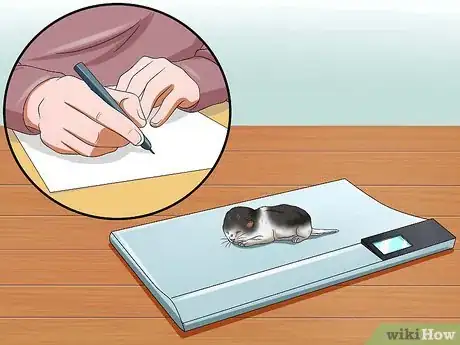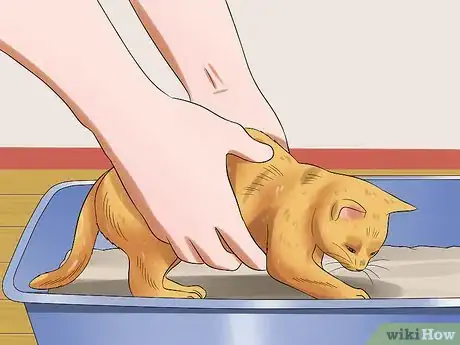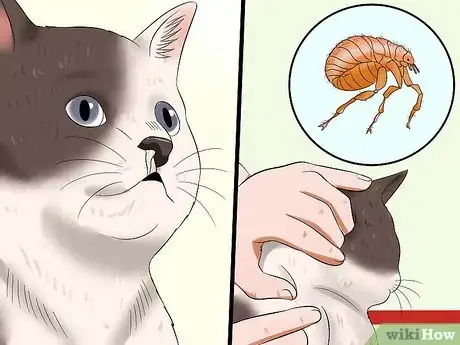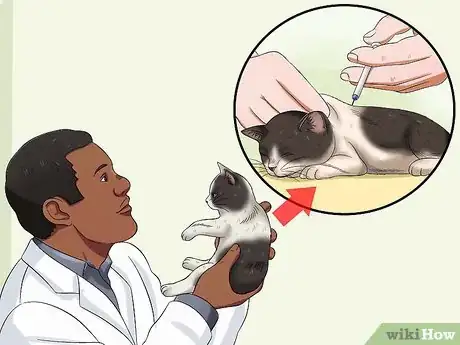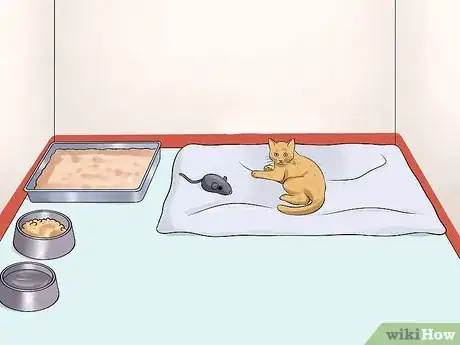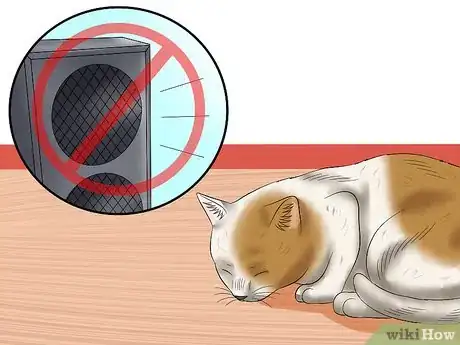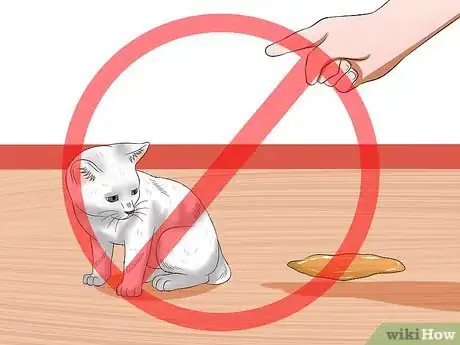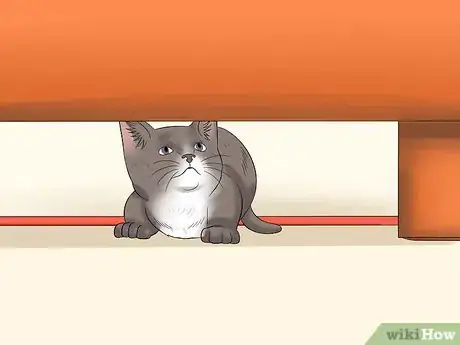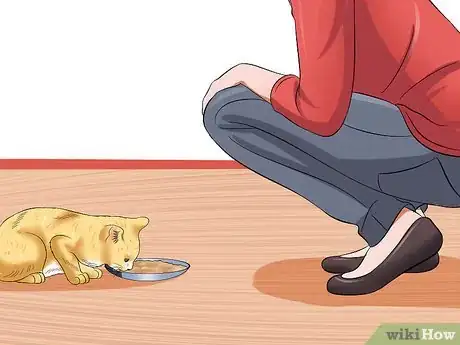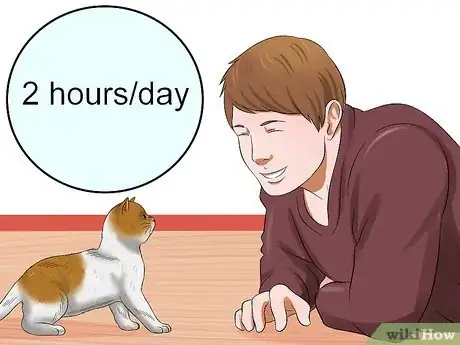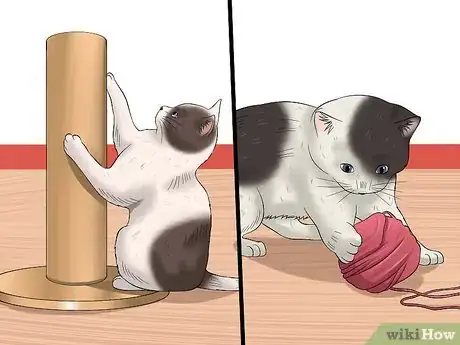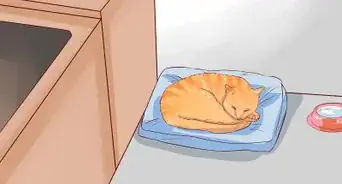This article was co-authored by Pippa Elliott, MRCVS. Dr. Elliott, BVMS, MRCVS is a veterinarian with over 30 years of experience in veterinary surgery and companion animal practice. She graduated from the University of Glasgow in 1987 with a degree in veterinary medicine and surgery. She has worked at the same animal clinic in her hometown for over 20 years.
wikiHow marks an article as reader-approved once it receives enough positive feedback. In this case, 86% of readers who voted found the article helpful, earning it our reader-approved status.
This article has been viewed 112,023 times.
Unfortunately stray cats and kittens are common in many areas of North America. Most (but not all) stray cats are feral, which means it is highly unlikely they’d ever be socialized enough to live indoors with humans. Stray kittens, however, have a better chance of becoming pets if they’re able to be socialized. If you find a stray (or feral) kitten, there are several things you can do to help it survive and socialize it to be a pet.
Steps
Providing Emergency Food and Shelter
-
1Be sure the kitten is actually abandoned. Mother cats are not always able to stay with their kittens, they have to leave the kittens alone in order to find food for themselves. If you find one or more stray kitten, you need to be sure it has actually been abandoned by its mother before you take it inside.[1] [2] [3]
- Unfortunately the only way to know for sure if the kitten is abandoned is to wait and watch the kitten. You’ll need to do this from a distance where the mother cat cannot see or smell you.
- If you wait a few hours and the mother cat doesn’t return, there is a good chance she’s not going to return.
- If the mother cat returns, it is best if the kitten stays with her until the kitten is weaned. Until then, you can help the mother cat by providing her with food, water, and some shelter.
- Once the kitten is weaned, you can decide if you want to bring her inside and try to socialize her, or leave her to live outside.
- Many stray cats and kittens actually live in colonies. If a kitten is at least 4 months old it can survive in the colony on its own.
-
2Estimate the kitten’s age. A kitten needs different care depending on its age, so the first thing you should do is try to estimate how old the kitten is. You can perform this estimation before touching the kitten and bringing it inside, if you can see her clearly.[4]
- A newborn kitten who is less than a week old will: weigh approximately 3 to 8 ounces, have her eyes closed, have her ears folded down, and be unable to walk. She might even have a piece of her umbilical code still attached to her belly.
- A kitten who is between 1 and 2 weeks old will: weigh 8 to 11 ounces, have slightly open blue eyes, slightly open ears, and will attempt to move around.
- A kitten who is around 3 weeks old will: weigh 8 to 15 ounces, have open eyes and ears, be able to take tentative steps, and respond to noises and other movements.
- A kitten who is between 4 and 5 weeks old will: weigh 8 to 17 ounces, be able to run and play with her litter mates, be able to eat wet food, and will no longer have blue eyes.
Advertisement -
3Try to find a mother cat who is already nursing. Mother cats who are nursing have very strong maternal instincts and have been known to adopt other kittens into their litters. Since a mother cat’s milk is the absolute best food a kitten can be given, and a mother cat already knows how to take care of a kitten, being able to give the kitten to a nursing mother is the best option.[5]
- Call your local humane society, veterinarian offices, and rescue organizations and ask if anyone has a mother cat who could take on an extra kitten (or two).
- Even if the kitten can be given to a nursing mother, you can still agree to take the kitten back once it’s been weaned.
-
4Keep the kitten warm and dry. Kittens have a lot of trouble regulating their own body temperatures (in fact, they cannot control their body temperatures at all until they’re at least 3 weeks old), therefore they need a lot of help to stay warm. Usually kittens will cuddle with their mother to keep warm, or they’ll cuddle with each other (often in a pile, one on top of the other).[6] [7]
- If the kitten is cold to the touch, warm her up with your own body heat. Use your hands to rub her body and increase blood circulation.
- Use a box, laundry basket, plastic tub, etc., and build the kitten a nest. Put blankets and towels inside the box to help keep her warm and prevent her from falling or climbing out.
- You can also put a heating pad inside the box (under a towel) if you need to, but make sure it’s only under a portion of the towel so the kitten can move away from the heat if she’s too hot.
- Because the kitten doesn’t have a mother cat to clean up after her, the bedding is going to get messy. Make sure to change it often so the kitten doesn’t get wet. If she does get wet, wipe off the mess and dry her with a towel.
-
5Purchase kitten formula. A kitten can only drink kitten formula. Do not ever give a kitten any other type of milk that you may have on hand. This likely means you’ll have to go out and purchase some kitten formula at the pet food store as soon as possible.[8]
- In addition to the formula, you’ll also need to purchase a bottle for the kitten. They’re likely sold in the same section as the formula.
- If available, purchase an elongated nipple for the bottle as they’re easier for the kitten to drink from.
-
6Make emergency kitten formula. If you need to feed the kitten, but there are no stores open, you can make up an emergency formula from things you may have at home. If you don’t have all the ingredients, chances are there’s a grocery store open even if the pet store is closed. This formula should only be used for emergency purposes, as its ingredients can potentially be dangerous for the kitten. Milk can cause diarrhea and eggs can contain salmonella, both of which can be fatal to a kitten.[9]
- Option 1 — Mix together an 8 ounce can of evaporated milk with 1 egg yolk and 2 tablespoons of karo syrup. Strain the mixture to remove any lumps. Keep the mixture in the fridge until you need it for feedings. Make a bottle with ½ this mixture and ½ boiling water when it’s time for a feeding. Allow the mixture to cool before giving it to the kitten.
- Option 2 — Mix together 2 cups of whole milk, 2 raw egg yolks (organic if possible), and 2 tablespoons of protein powder. You may need to use a fork or a whisk to mix these ingredients together. Warm them up by putting the bottle in a bowl of warm water.
-
7Feed the kitten based on a schedule. Kittens need to be fed as often as every 2 hours, depending on their age. Kittens also need to be fed while on their tummies, with the bottle upwards but at a slight angle. The milk you feed a kitten must also be warmed up, but not hot.[10]
- Kittens 10 days old and younger need to be fed every 2 hours, around the clock, including the middle of the night.
- Kittens between 11 days old and 2.5 weeks old need to be fed every 3-4 hours, around the clock.
- Kittens between 2.5 and 4 weeks old need to be fed every 5-6 hours, around the clock.
- Once a kitten is 4-5 weeks of age, you can start weaning them off the bottle. You can do this by mixing formula with wet food and giving it to the kittens in a bowl, instead of a bottle. You can also start to give them dry food to see if they’re interested.
-
8Burp the kitten after a bottle. Just like human babies, kittens who are drinking formula via a bottle need to be burped when they’re done feeding. A kitten will usually stop drinking when she’s full, unless she’s having trouble latching onto the nipple of the bottle.[11]
- If the kitten isn’t latching onto the bottle, you can pull on the nipple when she's trying to drink to help encourage her to suck harder. You can also move the nipple around, again, to encourage the kitten to suck harder.
- If the kitten is ill you may need to feed them via a tube directly into their stomachs. You’ll need to go to a veterinarian before you attempt to do this.
- Once the kitten has finished drinking, place her on your shoulder or on her belly and pat her back gently until she burps.
- Once she’s burped, use a warm and wet cloth to wipe her off and remove any excess milk that might have missed her mouth.
-
9Stimulate the kitten so she pees. Kittens under the age of 4 weeks need help going pee and poo. Normally their mother will lick them to stimulate them to pee and poo, but since they have no mother, you’ll have to do this. Thankfully you don’t have to lick them, you can simply use a soft tissue or warm, moist cotton ball to do the job.[12]
- Use the tissue or cotton ball to gently rub their bum until they pee and poo.
- While they’re only drinking formula, a kitten’s poo won’t be solid or in normal poo shapes.
Deciding to Keep the Kitten
-
1Think carefully about your decision to take in the kitten. A kitten is adorable and it can be really hard not to want to take care of them. But raising a kitten (especially one that is still nursing) and socializing it to be a pet is a difficult and long process. You need to be sure you’re ready for that type of commitment.[13] [14]
- Also keep in mind that a stray kitten will need veterinarian care at some point. Standard care (e.g. vaccinations, spay/neuter, flea treatment, deworming, etc.) can cost several hundred dollars. Non-standard care (e.g. emergency visits, treatment of parasites or ringworm, upper respiratory infections, and more) can be very expensive and it can be hard to predict which kittens will need such treatment.
- If you aren’t able to take on such a commitment, you might be able to find someone else who can. Start with animal control and your local humane society. Also try local cat rescue organizations and other rescue organizations. You can also call veterinarian offices to inquiry if they know of someone who can help.
-
2Weigh the kitten regularly. In order to ensure the kitten is growing, weigh her every day. You might want to get into a schedule of weighing the kitten before every feeding, or at the same time every day. Record the kitten’s weight on a chart so you can keep track of it over time.[15]
- A kitten should double her weight in the first week of her life.
-
3Begin litter training. Once a kitten is 4 weeks old you can start teaching them how to use a little box. If a kitten starts looking for a place to go to the bathroom before 4 weeks of age, you can try putting out a little box even earlier.[16]
- Use a very shallow box for kittens. Many shelters and rescues use the box canned cat food is packed in.
- Use non-clumping litter for kittens. Do not use paper or towels to train a kitten as this may cause them to develop bad litter box habits that a future owner may not appreciate.
- After the kitten has eaten, place them in the litter box to encourage them to use it. You can also put a used cotton ball or tissue in with them to give them the idea of what they’re supposed to do.
-
4Watch the kitten for health problems. Unfortunately kittens, especially those who were born outside, can have a variety of health problems when they’re young. Watch for these problems while you’re taking care of them and take them to a veterinarian if you notice any of these problems developing.[17]
- Upper Respiratory Infections (URIs) are very common in kittens. If a kitten has yellow discharge coming out of their nose, or they’re having trouble breathing while they eat, they may have an URI. Depending on the severity of the infection, they may need to be given antibiotics.
- Fleas can also be quite common on cats that have come from the outdoors. For a kitten fleas can be deadly. If the kitten you’re caring for has fleas, start by combing them off with a flea comb, then give them a warm bath. Do not use flea shampoo on a kitten or a parasite medication like Revolution.
- Parasites can also be found in kittens from the outdoors. Parasites usually cause poo problems. If you notice this, take the kitten to your veterinarian who can provide you with a deworming treatment for a kitten as young as 10 days old.
-
5Take the kitten to the veterinarian for a wellness exam. As your kitten gets older, you need to take her to the veterinarian for a wellness exam and vaccinations — assuming you haven’t already taken her to the vet due to illness. Vaccinations are usually given in multiple doses over several weeks or months.[18]
Socializing a Stray Kitten
-
1Put the kitten in her own room. While a kitten is very young (less than 2 months at least) she should be kept by herself someplace safe and warm. As she gets older, you can expand the amount of space she has to move around and play.[19] [20]
- Make sure the location doesn’t have any hiding spots that your kitten can get into.
- You can use a cage if you don’t have a room small enough.
- Make sure their space has a bedding area, a litter box (when she's older), and a place for food and water dishes.
- The bedding should be setup in such a way that the kitten can comfortably hide in the blankets should she feel scared.
-
2Keep things quiet. Whenever you’re around the kitten, move slowly and quietly. You should also speak to her often so she gets use to human voices — but speak softly. Make sure the room she's in doesn’t have a lot of outside noise (if possible) and don’t play music in that room until she's really comfortable.[21]
- Once the kitten has been in your house for a little while, consider leaving a radio playing softly in her room when you’re not there.
- If the kitten isn’t scared, put her cage or bed in a more common area of the house (when you can supervise) so she gets use to the hustle and bustle of the house.
-
3Avoid punishment or scolding. A kitten is not going to know any better, so she may do things that you consider to be “bad.” If this happens, do not punish or scold her. Instead, reward her for good behaviour so she begins to realize the type of behaviour you’d like her to have. Once she catches on, she’ll start to repeat that good behaviour over and over.[22]
-
4Be patient. Depending on how old the kitten was when you brought her inside, it can take a while to socialize her and get her use to humans. Don’t rush the process. If you’re taking care of more than one kitten, consider separating them and spending one-on-one time with each of them.[23]
-
5Use food as an incentive to be around humans. All kittens love food — so you can use it as an incentive to help encourage your kitten to be more social. While you can leave dry food out for the kitten all day, only feed her wet food when you’re in the room. Get her to associate the wet food with you (the human) so she appreciates a human’s presence.[24] [25]
- Put the wet food bowls as close to you as possible while the kitten is eating.
- Gently pet and touch the kitten while she’s eating to get her use to your touch.
- Feed the kitten with a spoon to help them get use to you as well.
- You can also use pure meat baby food as a treat for a kitten. It cannot have anything else mixed in, only meat.
-
6Play with the kitten at least 2 hours a day. You should spend at least 2 hours a day with your kitten. This can be all at once, or multiple short periods, whatever works for you. Play with your kitten at ground level. If you have more than one kitten, take the time to handle each kitten individually everyday. Hold the kitten as much as you can, especially cuddling her close to your body. Introduce toys once the kitten becomes interested.[26]
-
7Introduce your kitten to new friends. If a kitten is comfortable with you and not stressed, you can start introducing her to other pets. You should always supervise these interactions as you cannot predict how anyone will behave. You can also start introducing the kitten to other humans, so she gets use to humans other than you.[27]
-
8Give the kitten more room to play. Once your kitten get older and starts to play with toys, you can make her play area larger and include more fun stuff for her to play with. In addition to toys, you can add a scratching post or cat tree (start with a short one), tunnels, cardboard boxes, etc.[28]
References
- ↑ http://www.alleycat.org/page.aspx?pid=907
- ↑ http://www.care2.com/causes/7-things-to-do-if-you-find-stray-kittens.html
- ↑ http://www.canadianliving.com/life/pets/what_to_do_with_stray_kittens_10_dos_and_donts.php
- ↑ http://www.alleycat.org/page.aspx?pid=907
- ↑ http://www.alleycat.org/page.aspx?pid=907
- ↑ http://www.alleycat.org/page.aspx?pid=907
- ↑ http://www.canadianliving.com/life/pets/what_to_do_with_stray_kittens_10_dos_and_donts.php
- ↑ http://www.alleycat.org/page.aspx?pid=907
- ↑ http://www.alleycat.org/page.aspx?pid=907
- ↑ http://www.alleycat.org/page.aspx?pid=907
- ↑ http://www.alleycat.org/page.aspx?pid=907
- ↑ http://www.alleycat.org/page.aspx?pid=907
- ↑ http://www.alleycat.org/page.aspx?pid=907
- ↑ http://www.care2.com/causes/7-things-to-do-if-you-find-stray-kittens.html
- ↑ http://www.feralcat.com/pdf/raising-orphan-kittens.pdf
- ↑ http://www.alleycat.org/page.aspx?pid=907
- ↑ http://www.alleycat.org/page.aspx?pid=907
- ↑ http://www.alleycat.org/page.aspx?pid=907
- ↑ http://www.alleycat.org/page.aspx?pid=907
- ↑ http://urbancatleague.org/TamingFerals
- ↑ http://www.alleycat.org/page.aspx?pid=907
- ↑ http://www.alleycat.org/page.aspx?pid=907
- ↑ http://www.alleycat.org/page.aspx?pid=907
- ↑ http://www.alleycat.org/page.aspx?pid=907
- ↑ http://urbancatleague.org/TamingFerals
- ↑ http://www.alleycat.org/page.aspx?pid=907
- ↑ http://www.alleycat.org/page.aspx?pid=907
- ↑ http://www.alleycat.org/page.aspx?pid=907
- ↑ http://www.alleycat.org/page.aspx?pid=907
- ↑ http://www.canadianliving.com/life/pets/what_to_do_with_stray_kittens_10_dos_and_donts_2.php
About This Article
To care for a stray kitten, try to find a mother cat who is already nursing. If that's not an option, get kitten formula from a pet store. Warm up the formula slightly, put the kitten on its tummy, and hold the bottle at a slight angle to feed it. Then, pat its back gently to burp it. Try to feed and burp the kitten this way every 2 hours. Finally, put soft blankets or towels inside of a box or laundry basket and nestle the kitten inside to keep it warm. For tips on stimulating the kitten's bladder to help it urinate, read on!

